NISSAN PATHFINDER 1998 R50 / 2.G Service Manual
Manufacturer: NISSAN, Model Year: 1998, Model line: PATHFINDER, Model: NISSAN PATHFINDER 1998 R50 / 2.GPages: 249, PDF Size: 2.14 MB
Page 41 of 249

5. Before placing the child in the child re-
straint, use force to tilt the child restraint
from side to side, and tug it forward to make
sure that it is securely held in place.
6. Check that the retractor is in the automatic
locking mode by trying to pull more belt out
of the retractor. If you cannot pull any more
belt webbing out of the retractor, the belt is
in the automatic locking mode.
7. Check to make sure that the child restraint
is properly secured prior to each use. If the
belt is not locked, repeat steps 3 through 6.After the child restraint is removed and the
seat belt is allowed to wind back into the
retractor, the automatic locking mode (child
restraint mode) is canceled; the seat belt only
locks during a sudden stop or impact.
TOP STRAP CHILD RESTRAINTIf your child restraint has a top strap, it must be
secured to the provided anchor point. Anchor
bracket hardware must be installed. The top
strap anchor bracket is available through your
NISSAN dealer.
Part No. 88894-89900
Secure the child restraint with the center lap
belt or the lap portion of an outboard three-
point belt and latch the top strap hook onto the
appropriate anchor bracket. To install the an-
chor bracket, a metric bolt of the dimensions
listed below must be used.
SSS0110
SSS0065
1-34
Seats, restraints and supplemental air bag systems
Z
01.1.31/R50-D
X
Page 42 of 249
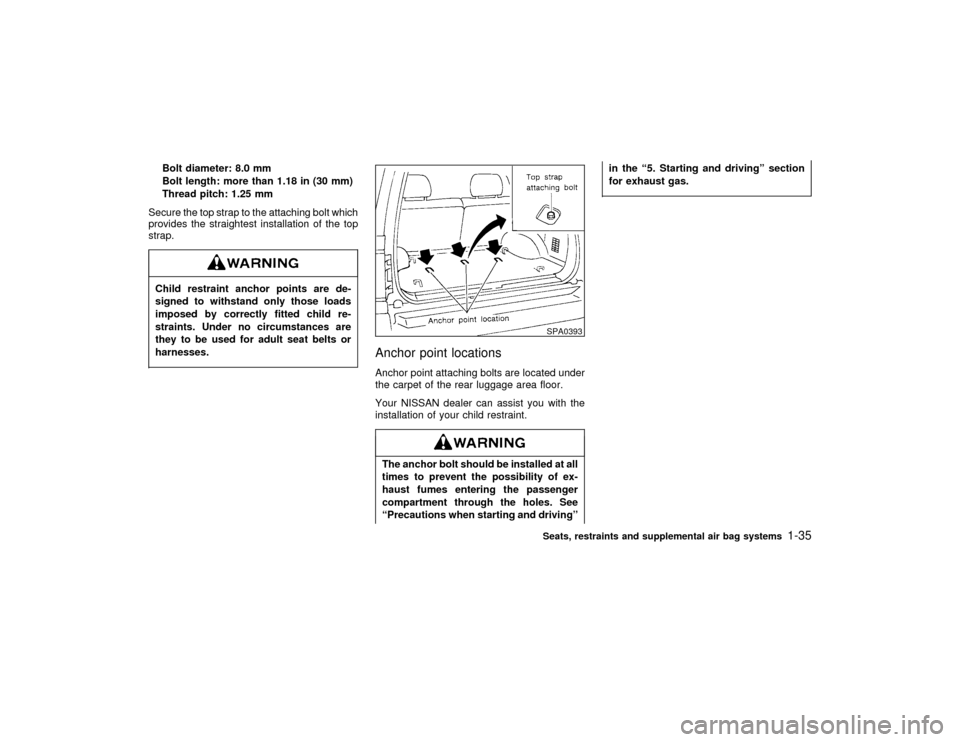
Bolt diameter: 8.0 mm
Bolt length: more than 1.18 in (30 mm)
Thread pitch: 1.25 mm
Secure the top strap to the attaching bolt which
provides the straightest installation of the top
strap.Child restraint anchor points are de-
signed to withstand only those loads
imposed by correctly fitted child re-
straints. Under no circumstances are
they to be used for adult seat belts or
harnesses.
Anchor point locationsAnchor point attaching bolts are located under
the carpet of the rear luggage area floor.
Your NISSAN dealer can assist you with the
installation of your child restraint.The anchor bolt should be installed at all
times to prevent the possibility of ex-
haust fumes entering the passenger
compartment through the holes. See
ªPrecautions when starting and drivingºin the ª5. Starting and drivingº section
for exhaust gas.
SPA0393Seats, restraints and supplemental air bag systems
1-35
Z
01.1.31/R50-D
X
Page 43 of 249
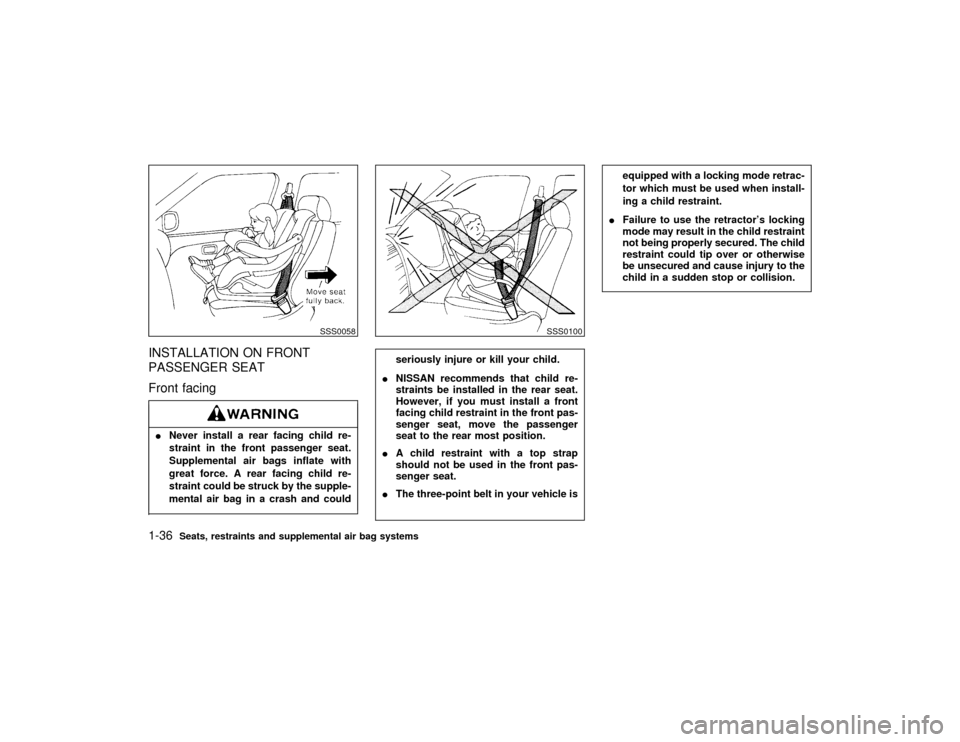
INSTALLATION ON FRONT
PASSENGER SEAT
Front facingINever install a rear facing child re-
straint in the front passenger seat.
Supplemental air bags inflate with
great force. A rear facing child re-
straint could be struck by the supple-
mental air bag in a crash and could
seriously injure or kill your child.
INISSAN recommends that child re-
straints be installed in the rear seat.
However, if you must install a front
facing child restraint in the front pas-
senger seat, move the passenger
seat to the rear most position.
IA child restraint with a top strap
should not be used in the front pas-
senger seat.
IThe three-point belt in your vehicle is
equipped with a locking mode retrac-
tor which must be used when install-
ing a child restraint.
IFailure to use the retractor's locking
mode may result in the child restraint
not being properly secured. The child
restraint could tip over or otherwise
be unsecured and cause injury to the
child in a sudden stop or collision.
SSS0058
SSS0100
1-36
Seats, restraints and supplemental air bag systems
Z
01.1.31/R50-D
X
Page 44 of 249
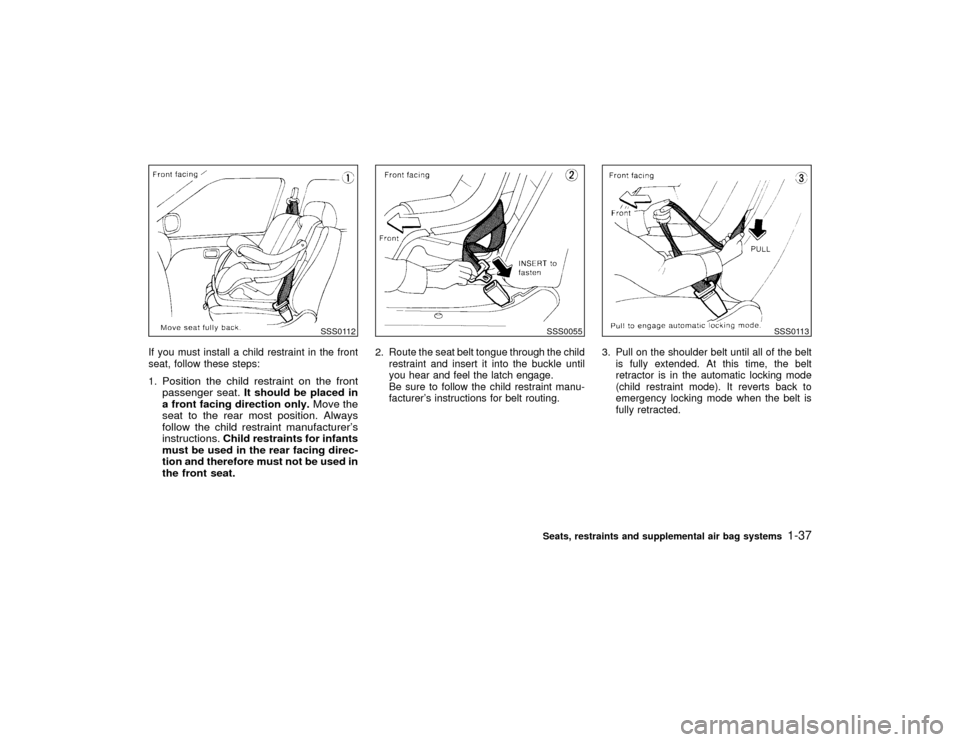
If you must install a child restraint in the front
seat, follow these steps:
1.
Position the child restraint on the front
passenger seat.It should be placed in
a front facing direction only.Move the
seat to the rear most position. Always
follow the child restraint manufacturer's
instructions.Child restraints for infants
must be used in the rear facing direc-
tion and therefore must not be used in
the front seat.
2. Route the seat belt tongue through the child
restraint and insert it into the buckle until
you hear and feel the latch engage.
Be sure to follow the child restraint manu-
facturer's instructions for belt routing.3. Pull on the shoulder belt until all of the belt
is fully extended. At this time, the belt
retractor is in the automatic locking mode
(child restraint mode). It reverts back to
emergency locking mode when the belt is
fully retracted.
SSS0112
SSS0055
SSS0113
Seats, restraints and supplemental air bag systems
1-37
Z
01.1.31/R50-D
X
Page 45 of 249
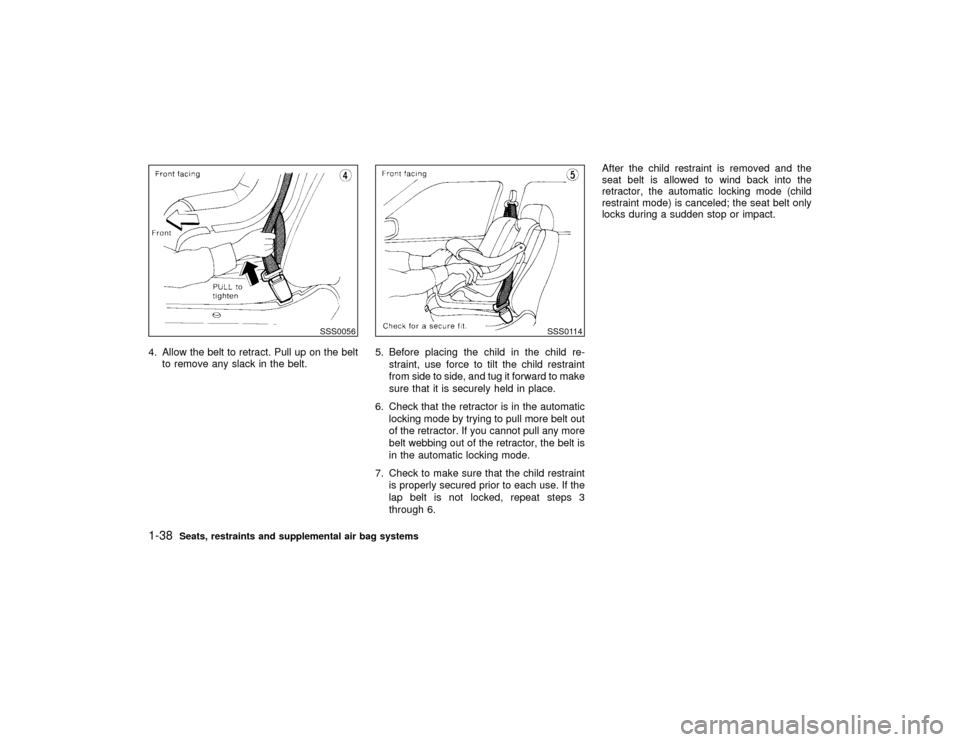
4. Allow the belt to retract. Pull up on the belt
to remove any slack in the belt.5. Before placing the child in the child re-
straint, use force to tilt the child restraint
from side to side, and tug it forward to make
sure that it is securely held in place.
6. Check that the retractor is in the automatic
locking mode by trying to pull more belt out
of the retractor. If you cannot pull any more
belt webbing out of the retractor, the belt is
in the automatic locking mode.
7. Check to make sure that the child restraint
is properly secured prior to each use. If the
lap belt is not locked, repeat steps 3
through 6.After the child restraint is removed and the
seat belt is allowed to wind back into the
retractor, the automatic locking mode (child
restraint mode) is canceled; the seat belt only
locks during a sudden stop or impact.
SSS0056
SSS0114
1-38
Seats, restraints and supplemental air bag systems
Z
01.1.31/R50-D
X
Page 46 of 249

2 Instruments and controlsInstrument panel ....................................................... 2-2
Meters and gauges ................................................... 2-3
Compass and outside temperature display
(if so equipped) ......................................................... 2-6
Warning/indicator lights and buzzers ........................ 2-9
Security system ....................................................... 2-14
Windshield wiper and washer switch ...................... 2-15
Rear window wiper and washer switch................... 2-16
Rear window and outside mirror
defogger switch ....................................................... 2-16
Headlight and turn signal switch ............................. 2-17
Front fog light switch ............................................... 2-19
Hazard warning flasher switch ................................ 2-19
Horn......................................................................... 2-20Heated seats (if so equipped) ................................. 2-20
Power socket........................................................... 2-21
Cigarette lighter and ashtrays ................................. 2-22
Storage .................................................................... 2-23
Windows .................................................................. 2-30
Sunroof (if so equipped) ......................................... 2-32
Clock ....................................................................... 2-33
Interior light ............................................................. 2-34
Personal light .......................................................... 2-35
Vanity mirror light .................................................... 2-35
Integrated HomeLink
transmitter
(if so equipped) ....................................................... 2-35
Z
01.1.31/R50-D
X
Page 47 of 249

Driver's supplemental air bag (P.1-9)
Cruise control
set switch
(P.5-16)
Outside mirror remote control
(P.3-14) Headlight/dimmer/turn signal switch (P.2-17)
Front fog light switch (P.2-19)Meter/gauge (P.2-3)
Windshield wiper/washer switch (P.2-15)
Hazard warning flasher switch (P.2-19)
Center ventilator (P.4-2)
Heater/air conditioner control (P.4-3)Compass/outside air temperature display (P.2-5)
Passenger supplemental air bag (P.1-9)
Side ventilator (P.4-2)
Glove box (P.2-25)
Cigarette lighter (P.2-22)
Radio/CD player (P.4-14)/clock (P.2-33)
Rear window wiper/washer switch (P.2-16)
Rear window/outside mirror defroster switch (P.2-16)Ignition switch/steering lock (P.5-6)Heated seat switch (P.2-20)
Tilting steering wheel adjust lever (P.3-13)Hood release handle (P.3-8)Fuse box cover (P.8-21)
Coin tray (P.2-23) Theft warning light (P.2-14) Cruise control main switch (P.5-16)
Instrument brightness control
(P.2-18)
SIC0682
See the page indicated in parentheses for operating details.
INSTRUMENT PANEL2-2
Instruments and controls
Z
01.1.31/R50-D
X
Page 48 of 249
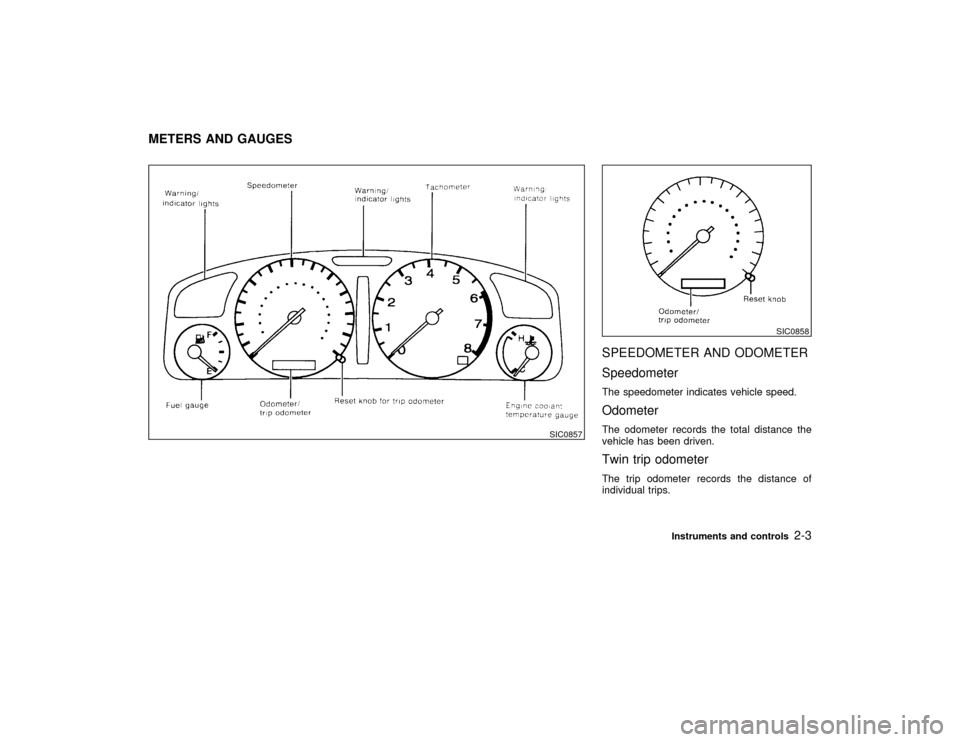
SPEEDOMETER AND ODOMETER
SpeedometerThe speedometer indicates vehicle speed.OdometerThe odometer records the total distance the
vehicle has been driven.Twin trip odometerThe trip odometer records the distance of
individual trips.
SIC0857
SIC0858
METERS AND GAUGES
Instruments and controls
2-3
Z
01.1.31/R50-D
X
Page 49 of 249
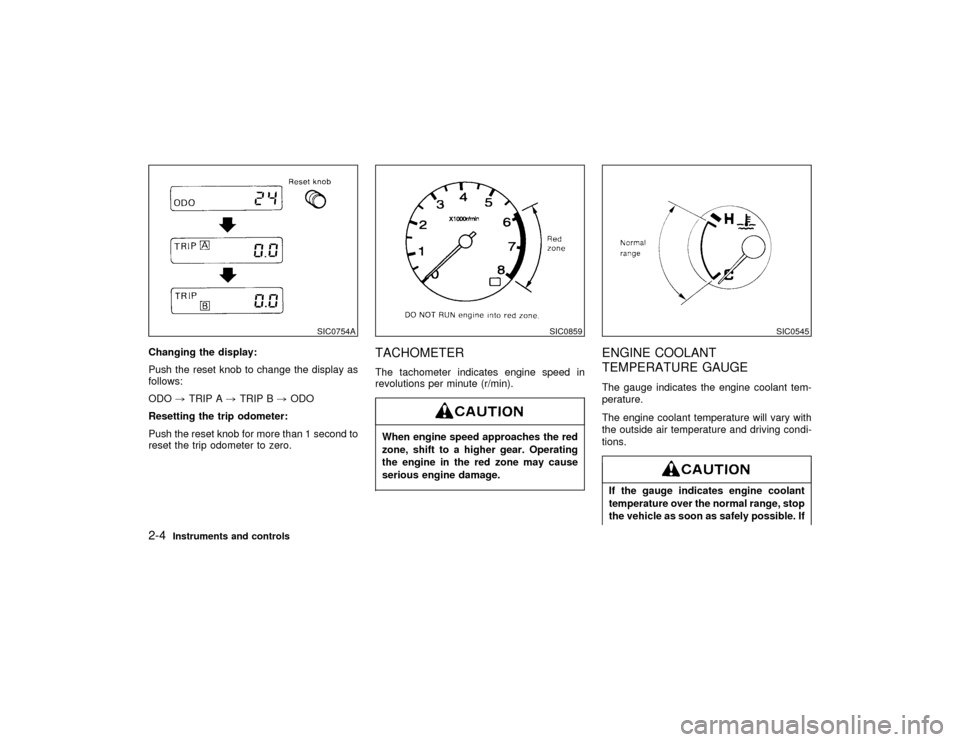
Changing the display:
Push the reset knob to change the display as
follows:
ODO,TRIP A,TRIP B,ODO
Resetting the trip odometer:
Push the reset knob for more than 1 second to
reset the trip odometer to zero.
TACHOMETERThe tachometer indicates engine speed in
revolutions per minute (r/min).When engine speed approaches the red
zone, shift to a higher gear. Operating
the engine in the red zone may cause
serious engine damage.
ENGINE COOLANT
TEMPERATURE GAUGEThe gauge indicates the engine coolant tem-
perature.
The engine coolant temperature will vary with
the outside air temperature and driving condi-
tions.If the gauge indicates engine coolant
temperature over the normal range, stop
the vehicle as soon as safely possible. If
SIC0754A
SIC0859
SIC0545
2-4
Instruments and controls
Z
01.1.31/R50-D
X
Page 50 of 249
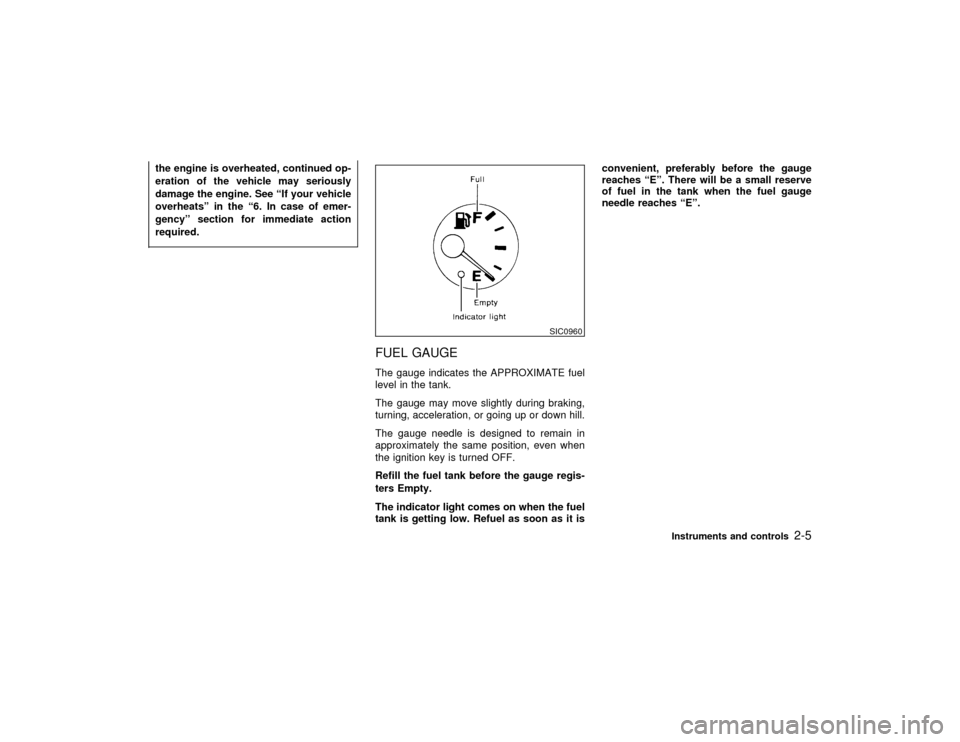
the engine is overheated, continued op-
eration of the vehicle may seriously
damage the engine. See ªIf your vehicle
overheatsº in the ª6. In case of emer-
gencyº section for immediate action
required.
FUEL GAUGEThe gauge indicates the APPROXIMATE fuel
level in the tank.
The gauge may move slightly during braking,
turning, acceleration, or going up or down hill.
The gauge needle is designed to remain in
approximately the same position, even when
the ignition key is turned OFF.
Refill the fuel tank before the gauge regis-
ters Empty.
The indicator light comes on when the fuel
tank is getting low. Refuel as soon as it isconvenient, preferably before the gauge
reaches ªEº. There will be a small reserve
of fuel in the tank when the fuel gauge
needle reaches ªEº.
SIC0960
Instruments and controls
2-5
Z
01.1.31/R50-D
X